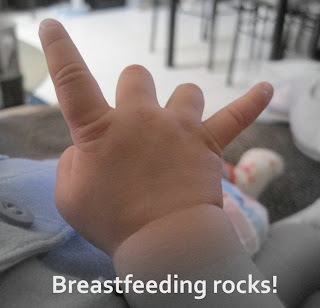For decades, breastfeeding suffered all-time lows, particularly in Western cultures. In the 70s, it was considered an activity reserved mainly for hippies. From 1980 onwards, majority of mothers around the world, including the Philippines, only breastfeed up to three months. At present, only a staggering 34% of Filipino mothers ever breastfeed.
In our family alone, I am one of the few women who have continued to breastfeed past three months, apart from an aunt who did so for two whole years. My sister breastfed for a month-and-a-half, and my mom, just about the same for all her three children. During their time, it was almost impossible to store breastmilk due to inavailability of electric pumps (they had those bell-shaped manual ones that don’t work).
Since breastmilk operates on a demand-and-supply basis and they were both out of the house most of the time to work, their breasts eventually just ceased producing milk.
Misconceptions forever shroud breastmilk’s nutritional value, such that it diminishes past the first 6 months, hence some mothers do not deem it necessary to go beyond the 6-month AAP-recommended exclusive breastfeeding mark.
 |
| Statistics show a growing trend in breastfeeding moms from the late 60s to the late 90s Source |
Thanks to Dr. Sears and a growing number of breastfeeding advocates worldwide, breastfeeding is making a glorious comeback. More mothers are slowly gaining awareness and are resorting to exclusive breastfeeding as a prime choice for their child’s nutrition.
What on earth is exclusive breastfeeding anyway?
As it denotes, it is breastfeeding, that is, well, exclusive. No infant formula, no water or glucose water, no juice, absolutely no other substitutes. Just pure breastmilk 24 hours of the day. Whether you’re giving it through a bottle, or directly from your breasts (direct feeding), it is considered exclusive breastfeeding so long as you give nothing but pure breastmilk.
Of course multivitamins are an exception, though most exclusively breastfeeding moms – including me – do not give multivitamins for at least the first 6 months of life because breastmilk contains ALL the vitamins and minerals that the baby needs, regardless of their mothers’ dietary preferences. Ain’t the human body simply ingenious?
Why exclusively breastfeed?
 |
| Can you tell that this woman is breastfeeding while wearing a ring sling? The sling’s tail doubles as a cover, too. Source |
Breastmilk is always fresh, pre-made and has the right temperature. There’s no risk of contamination, no water or bottles to sterilize.
Third is the cost. During Lia’s first week of life, we bought a high-end brand of S-26 in a carton, as prescribed by her former pedia. “Just in case you’re not producing enough milk and you have to go out and can’t bring the baby with you,” she said. It cost P280/ box (or around $6.50). The cheapest costs around P180 (approximately $4.50). For a newborn, that carton would probably last 2-3 days, and for a bigger baby, even less. Most people we know spend P2,000 ($50) per week for a baby who feeds pure milk.
Except for that box of formula, I never spent for milk – which has saved us roughly P20,000 ($500) to date. Imagine how much you can save in the long run if you’re exclusively breastfeeding.
Oh, and we ended up using the formula only once, for a 1-ounce mixture.
Challenges
As an exclusively breastfeeding mom for nearly 4 months, I could tell you too, that breastfeeding is not always a bagful of sunshine. First, there is the pain of engorgement postpartum.The first two weeks are especially excruciating. I dreaded each time that I had to nurse. Engorgement is a bitch, and your breasts will feel sore and heavy during this time. But to get past the pain, it’s necessary to endure it for now, along with nipple blisters, clogged ducts, low-grade fever and other breastfeeding challenges.Otherwise, you might end up with mastitis, which is a much bigger – and much more expensive – bi-atch. But not to worry, this gets better as your baby perfects his latching skills and as your milk supply stabilizes, which is approximately six weeks postpartum.
 |
| If you’re uncomfortable breastfeeding in public, you can always feed breastmilk in a bottle, then simply find a place to pump your milk on schedule. |
Too, your little one’s aim is poor, at best. You work as a team, and as his mother, it’s your duty to teach him how to latch properly so you don’t end up with painful nipple blisters and he’s able to feed properly.
Breastfeeding entails a great deal of self-denial.When you’re breastfeeding, addictions and other worldly pleasures (including tuna and other seafood high in mercury) may have to take a backseat. Your lifestyle may have to be adjusted accordingly. Traveling and going out can become quite a challenge as the little one gets his nutrition solely from you. There are things to be missed.
Finding the strength to breastfeed exclusively
 |
| Thanks to breastmilk, Lia is strong enough to roll over both ways and even doa half- guerilla crawl at 3 months. |
Yes, breastfeeding may not be for everybody. It is always the choice of the mother. But as one breastfeeding advocate said, breastfeeding may not always be the best choice for the mother, but it is ALWAYS the best choice for babies.
 |
| A breastfed baby is a healthy, happy baby 🙂 |
I salute women who choose to breastfeed – be it just for a day or two, a month, a year, or 3 years after that. In a world where priorities are ever-evolving and where breastfeeding is mostly associated to a low socio-economic status, any attempt to breastfeed is worth celebrating.
I’m not saying I could go beyond the six-month mark. Even six months seem like a pretty tough feat. But with the help of a very supportive breastfeeding (and n@w) community, friends and relatives, it’s not too hard to hang on for one more day of pure latching and zero formula.


